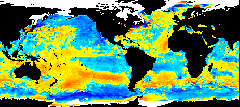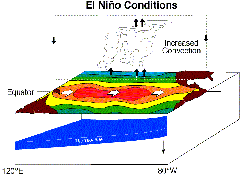|
NOAA Magazine || NOAA Home Page NOAA PREDICTS SEA SURFACE TEMPERATURES WILL RISE IN EASTERN TROPICAL PACIFIC Forecasters' Confidence Increases That El Niño Will Develop
Based on the latest observed oceanic and atmospheric circulation patterns, sea-surface temperature predictions and the time of year, NOAA scientists say it seems likely an El Niño will develop in the tropical Pacific in the next three months. "This warming represents an early stage of El Niño's onset. If the warming persists, it will be several more months before mature El Niño conditions develop. The impacts will depend on the strength of the event, which we can't determine at this time," said NOAA Administrator Vice Admiral Conrad C. Lautenbacher, Jr. Confidence in this forecast is based on improvements in NOAA's ability to monitor the equatorial Pacific in real-time, research advancements and improvements in NOAA National Centers for Environmental Prediction statistical and dynamical forecast models. "Our ability to predict El Niño is dependent upon a robust suite of operational observatories such as the Tropical Ocean-Global Atmosphere (TOGA) array in the equatorial pacific and satellites overhead. These ocean and atmospheric observing systems hold great potential for predicting climate fluctuations on all scales around the globe that have enormous economic impacts in the U.S. and abroad," said Lautenbacher. Over the past year, NOAA scientists have observed a slow trend toward El Niño, as below-normal sea surface temperatures (-1°C) in the central equatorial Pacific gave way to above-normal sea surface temperatures (+1° C) in the central Pacific.
El Niño episodes occur roughly every four-to-five years and can last up to 12-to-18 months. It has been nearly four years since the end of the 1997-1998 El Niño, which was followed by three years of La Niña. Critical to NOAA's advanced global climate monitoring capabilities is the NOAA polar orbiting satellite and the TAO/TRITON (Tropical Atmospheric-Ocean) Buoy Array, consisting of approximately 70 moored buoys, spanning the Equatorial Pacific Ocean and relaying atmospheric and oceanographic data in real-time to shore-based computers via the NOAA Argo array system. The array is a major component of NOAA's El Niño/Southern Oscillation (ENSO) Observing System. NOAA will continue to monitor for developments and provide monthly updates. The next scheduled El Niño discussion will be published by early March. The ENSO Diagnostic Discussion is a team effort of NOAA and its funded institutions. The team consists of the Climate Prediction Center (lead), Climate Diagnostics Center, Geophysical Fluid Dynamics Laboratory, National Climatic Data Center, Atlantic Oceanographic and Meteorological Laboratory, and the International Research Institute for Climate Prediction. NOAA's National Weather Service is the primary source of weather data, forecasts and warnings for the United States and its territories. NWS operates the most advanced weather and flood warning and forecast system in the world, helping to protect lives and property and enhance the national economy. Relevant Web Sites ENSO Frequently Asked Questions Sea Surface Temperature Outlook
|

